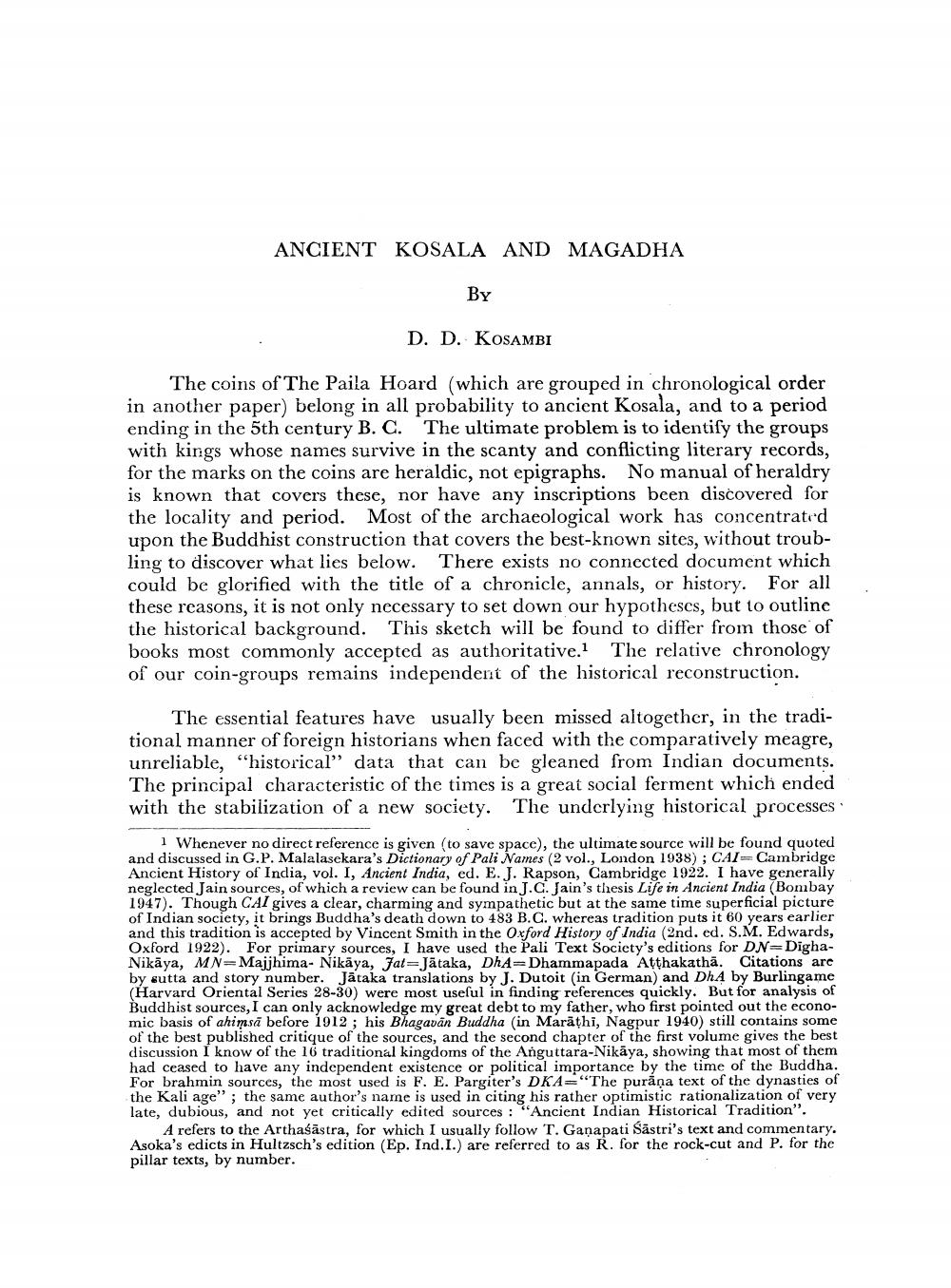Book Title: Ancient Kosala And Mmagadha Author(s): Dharmanand Kosambi Publisher: D D Kosambi View full book textPage 1
________________ ANCIENT KOSALA AND MAGADHA By D. D. KOSAMBI The coins of The Paila Hoard (which are grouped in chronological order in another paper) belong in all probability to ancient Kosala, and to a period ending in the 5th century B. C. The ultimate problem is to identify the groups with kings whose names survive in the scanty and conflicting literary records, for the marks on the coins are heraldic, not epigraphs. No manual of heraldry is known that covers these, nor have any inscriptions been discovered for the locality and period. Most of the archaeological work has concentrated upon the Buddhist construction that covers the best-known sites, without troubling to discover what lies below. There exists no connected document which could be glorified with the title of a chronicle, annals, or history. For all these reasons, it is not only necessary to set down our hypotheses, but to outline the historical background. This sketch will be found to differ from those of books most commonly accepted as authoritative. The relative chronology of our coin-groups remains independent of the historical reconstruction. The essential features have usually been missed altogether, in the traditional manner of foreign historians when faced with the comparatively meagre, unreliable, "historical” data that can be gleaned from Indian documents. The principal characteristic of the times is a great social ferment which ended with the stabilization of a new society. The underlying historical processes 1 Whenever no direct reference is given to save space), the ultimate source will be found quoted and discussed in G.P. Malalasekara's Dictionary of Pali Names (2 vol., London 1938); CAI=Cambridge Ancient History of India, vol. I, Ancient India, ed. E. J. Rapson, Cambridge 1922. I have generally neglected Jain sources, of which a review can be found in J.C. Jain's thesis Life in Ancient India (Bombay 1947). Though CAI gives a clear, charming and sympathetic but at the same time superficial picture of Indian society, it brings Buddha's death down to 483 B.C. whereas tradition puts it 60 years earlier and this tradition is accepted by Vincent Smith in the Oxford History of India (2nd, ed. S.M. Edwards, Oxford 1922). For primary sources, I have used the Pali Text Society's editions for DN=DighaNikāya, MN-Majjhima- Nikaya, Fat=Jātaka, DhA=Dhammapada Atthakathā. Citations are by sutta and story number. Jätaka translations by J. Dutoit (in German) and DhA by Burlingame (Harvard Oriental Series 28-30) were most useful in finding references quickly. But for analysis of Buddhist sources, I can only acknowledge my great debt to my father, who first pointed out the economic basis of ahimsā before 1912 ; his Bhagavān Buddha (in Marathi, Nagpur 1940) still contains some of the best published critique of the sources, and the second chapter of the first volume gives the best discussion I know of the 16 traditional kingdoms of the Anguttara-Nikāya, showing that most of them had ceased to have any independent existence or political importance by the time of the Buddha. For brahmin sources, the most used is F. E. Pargiter's DKA="The purāņa text of the dynasties of the Kali age"; the same author's name is used in citing his rather optimistic rationalization of very late, dubious, and not yet critically edited sources : "Ancient Indian Historical Tradition". A refers to the Arthaśāstra, for which I usually follow T. Ganapati Šāstri's text and commentary. Asoka's edicts in Hultzsch's edition (Ep. Ind.I.) are referred to as R. for the rock-cut and P. for the pillar texts, by number.Page Navigation
1 2 3 4 5 6 7 8 9 10 11 12 ... 34
